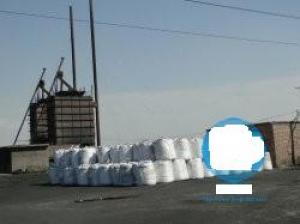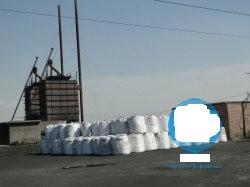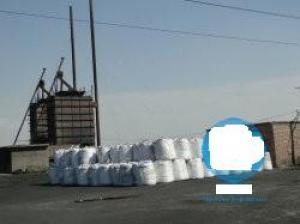Carbon Aditive 90%min
- Loading Port:
- China Main Port
- Payment Terms:
- TT OR LC
- Min Order Qty:
- -
- Supply Capability:
- -
OKorder Service Pledge
OKorder Financial Service
You Might Also Like
1.Features:
Carbon Additive also called Calcined anthracite Coal, Gas Calcined Anthracite Coal, Carbon Raiser.
The main raw material is Ningxia unique high quality anthracite, with characteristic of low ash and low sulfur. Carbon additive has two main uses, namely as the fuel and additive. When being used as the carbon additive of steel-smelting, and casting, the fixed carbon may achieve above 95%.
2.Application:
It may substitute massively refinery coke or the stone grinds. Meanwhile its cost is much less than the refinery coke and the stone grinds. Carbon Additive may also use as the fuel, for its calorific value may achieve above 9386K/KG. It may substitute burnt carbon massively. The burnt carbon exportation needs the quota; therefore the carburizing agent price superiority is similarly obvious.
3.Specifications:Chemical Composition(%) | ||||
F.C. | Ash | V.M. | S | Moisture |
%(min) | %(max) | |||
90 | 8.5 | 1.5 | 0.35 | 1.0 |
0.5-3mm, 1-4mm,0.5-4mm,1-3mm, 90%min,or at customer’s option; | ||||
In 1000kgs big bag; or 1200kgs big bag; or 25kgs small bag, then into 1000kgs big bag; or 25kgs or 50kgs small bag, then put into containers directly;or at customer’s option;
| ||||
- Q: What should we do to reduce carbon emissions in our lives?
- The use of public transport, of course, is best to walk long distances, as far as possible the use of roads or railways, aircraft carbon emissions, the largest use of disinfection chopsticks, do not use disposable tableware, handkerchiefs do not use napkins
- Q: What is the density of carbon?
- The density of carbon is approximately 2.26 grams per cubic centimeter.
- Q: What is the carbon content of different types of soil?
- Various factors, such as climate, vegetation, and land management practices, can greatly influence the carbon content of different types of soil. Generally, soils with higher levels of organic matter exhibit higher levels of carbon. For instance, peat soils boast the highest carbon content among all soil types, ranging from 30% to 60%. These soils form in wetland areas where the decomposition of organic matter is hindered by water saturation, resulting in the accumulation of substantial amounts of carbon over time. Forest soils also tend to possess relatively high carbon content, typically falling between 1% and 10%. Forests continually supply organic matter through litterfall, contributing to the build-up of carbon in the soil. In contrast, agricultural soils generally exhibit lower carbon content compared to peat or forest soils. Factors such as crop rotation, organic amendments, and tillage practices influence the carbon content of agricultural soils. Consequently, the carbon content in these soils can range from less than 1% to around 6%. Grassland soils may have carbon contents similar to agricultural soils, depending on management practices. However, in undisturbed grasslands with high plant productivity, the carbon content can be relatively higher, ranging from 2% to 8%. In arid and desert regions, soils tend to display lower carbon content due to limited vegetation and slower rates of organic matter decomposition. Typically, the carbon content in these soils is less than 1%. It is important to acknowledge that these ranges are generalizations, and the carbon content of soil can vary both within and between soil types. Additionally, alterations in land use, such as deforestation or the conversion of grasslands to agriculture, can have a significant impact on soil carbon content.
- Q: What are the consequences of increased carbon emissions on urban areas?
- Urban areas are significantly affected by the increase in carbon emissions, which have notable impacts on various aspects. One of the most significant consequences is the worsening of air pollution. The release of harmful pollutants like nitrogen oxides and particulate matter is contributed by carbon emissions, especially from vehicles and industrial activities. These pollutants can cause respiratory problems, worsen existing health conditions, and increase the risk of lung cancer and cardiovascular diseases among urban residents. Moreover, the increase in carbon emissions leads to the occurrence of urban heat islands. This happens because carbon dioxide and other greenhouse gases trap heat in the atmosphere, resulting in higher temperatures in urban areas. This effect is particularly pronounced due to the abundance of concrete and asphalt surfaces that absorb and radiate heat. Consequently, urban areas experience higher temperatures compared to nearby rural areas, further intensifying the discomfort and health risks associated with heat stress, particularly for vulnerable populations like the elderly and those with limited access to cooling resources. The consequences of increased carbon emissions also extend to the natural environment. Urban green spaces and ecosystems are negatively affected as higher levels of carbon dioxide disrupt plant growth and reduce biodiversity. This exacerbates the loss of natural habitats and the degradation of urban ecosystems, leading to a decline in the provision of ecosystem services such as air purification, temperature regulation, and stormwater management. Additionally, increased carbon emissions have economic implications for urban areas. As carbon emissions rise, the cost of addressing climate change-related challenges like flooding and extreme weather events increases. This puts a strain on the budgets of local governments and may result in higher taxes or reduced funding for other essential services. To tackle these consequences, it is crucial for urban areas to implement strategies that reduce carbon emissions and promote sustainability. This includes investing in public transportation, encouraging the use of renewable energy sources, promoting energy-efficient buildings, and implementing policies to reduce vehicle emissions. By adopting these measures, urban areas can mitigate the negative effects of increased carbon emissions and create healthier, more sustainable environments for their residents.
- Q: How does carbon affect water quality?
- Carbon can affect water quality by altering its pH level and reducing its oxygen content. Additionally, carbon can react with other chemicals present in water to form harmful compounds, compromising its overall quality and making it unsuitable for consumption and aquatic life.
- Q: A carbon Roast Lamb Leg stores need to how much money
- You buy yourself a Roasted Whole Lamb furnace, generally in the 2600-3000 Roasted Whole Lamb Roast Lamb Leg can fix, baking method will provide. Can buy Roasted Whole Lamb furnace Ji'nan Thebaud Hardware Products Co. Ltd.
- Q: Is the hardness or softness of the steel with higher carbon content?
- With the increase of carbon content, the strength and hardness of steel increase, while the plasticity and toughness decrease. When the carbon content is more than 1%, the strength of steel decreases.
- Q: Who is the high carbon content of stainless steel and ordinary steel?
- This is not necessarily stainless steel is carbon steel, based on the addition of zinc, nickel and chromium and other elements
- Q: What are the advantages of carbon-based fuel cells?
- There are several advantages of carbon-based fuel cells. Firstly, carbon-based fuel cells, such as those using hydrogen or methanol, have a high energy density, allowing for longer operating times and greater efficiency. Secondly, carbon-based fuel cells are environmentally friendly as they produce fewer emissions compared to traditional fossil fuel combustion. Additionally, carbon-based fuel cells are versatile and can be used in a variety of applications, from powering vehicles to providing electricity for homes and businesses. Finally, carbon-based fuel cells offer a promising alternative to traditional energy sources, reducing our dependence on finite resources and contributing to a more sustainable future.
- Q: How does carbon impact the availability of clean air?
- Carbon impacts the availability of clean air through its contribution to air pollution and climate change. When carbon-based fuels such as coal, oil, and natural gas are burned for energy production, they release carbon dioxide (CO2) into the atmosphere. CO2 is a greenhouse gas that traps heat in the Earth's atmosphere, causing the planet to warm up, leading to climate change. Climate change, in turn, affects air quality in several ways. Rising temperatures can increase the frequency and intensity of wildfires, which release large amounts of carbon dioxide and other pollutants into the air. Additionally, higher temperatures can exacerbate the formation of ground-level ozone, a harmful air pollutant that can trigger respiratory issues and other health problems. Furthermore, carbon emissions contribute to the formation of particulate matter, such as soot and fine particles, which can be harmful when inhaled. These particles can come from the burning of fossil fuels in vehicles, power plants, and industrial processes. Particulate matter can cause respiratory and cardiovascular problems and is especially harmful to vulnerable populations like children, the elderly, and those with pre-existing respiratory conditions. Reducing carbon emissions is crucial to improving air quality and ensuring the availability of clean air. Transitioning to renewable energy sources, improving energy efficiency, and implementing policies to reduce carbon emissions can all help mitigate the impact of carbon on air quality. Additionally, promoting sustainable transportation, reducing deforestation, and adopting cleaner industrial practices can contribute to cleaner air by reducing carbon emissions and other pollutants.
Send your message to us
Carbon Aditive 90%min
- Loading Port:
- China Main Port
- Payment Terms:
- TT OR LC
- Min Order Qty:
- -
- Supply Capability:
- -
OKorder Service Pledge
OKorder Financial Service
Similar products
Hot products
Hot Searches
Related keywords






















